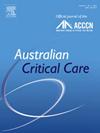不同呼吸条件下脱机困难患者的吸气力和呼吸肌激活:一项探索性研究。
IF 2.6
3区 医学
Q2 CRITICAL CARE MEDICINE
引用次数: 0
摘要
背景:最近的研究表明,在吸气肌训练(IMT)过程中,对低或高外部负荷进行快速和深度吸气可能会给脱机困难的患者提供训练刺激。然而,外部IMT负荷(由气道压力波动变化反映)(ΔPaw)与总吸气力(由食管压力波动测量)(ΔPes)之间的关系仍未得到探讨。此外,ΔPes、ΔPaw和吸气肌激活之间的关系尚不清楚。目的:本研究的目的是比较不同呼吸条件下脱机困难患者ΔPes和ΔPaw与吸气肌激活的关系。方法:ΔPes和斜角肌、胸锁乳突肌、胸骨旁肋间肌在以下条件下的激活情况:1)(比例)压力支持通气;2)无支撑的自主呼吸;3)低负荷IMT(负载:2O)以慢、深激励执行(低负荷慢),4)低负荷IMT(负载:2O)以快、深激励执行(低负荷快);5)高负载IMT(负载~ 30% PImax)以快速和深刻的灵感执行。ΔPaw,记录条件2-5时吸气末肺容积和吸气峰值流量。使用混合模型分析比较不同条件下的变量。计算了吸气肌激活与ΔPes和ΔPaw之间的Spearman秩相关。结果:5例患者(年龄:68±1岁;男性20%;PImax: 37±7 cmH2O[预测值59±23%];用力肺活量:0.66±0.16 L[预测值21±6%])纳入研究。在无支持的自主呼吸和IMT条件下,ΔPes值比ΔPaw值大3-4倍。ΔPes、胸锁乳突肌激活、吸气末肺体积和峰值吸气流量在低负荷快速IMT期间大于低负荷缓慢IMT和无支持的自发呼吸,但在低负荷快速IMT和高负荷IMT之间相似。吸气肌激活与ΔPaw中度相关,与ΔPes中度相关。结论:在5例有脱机困难的患者中,低负荷快速IMT提供了与高负荷IMT相似的训练刺激。两者都比低负荷慢速IMT和无支持的自发呼吸产生更高的训练刺激。这些结果应该考虑在未来的试验中比较IMT和假条件。临床试验注册号:NCT03240263和NCT04658498。本文章由计算机程序翻译,如有差异,请以英文原文为准。
Inspiratory effort and respiratory muscle activation during different breathing conditions in patients with weaning difficulties: An exploratory study
Background
Recent studies suggest that fast and deep inspirations against either low or high external loads may provide patients with weaning difficulties with a training stimulus during inspiratory muscle training (IMT). However, the relationship between external IMT load, reflected by changes in airway pressure swings (ΔPaw), and total inspiratory effort, measured by oesophageal pressure swings (ΔPes), remains unexplored. Additionally, the association between ΔPes, ΔPaw, and inspiratory muscle activations remains unclear.
Objectives
The ai of this study was to compare ΔPes and ΔPaw and their relationship with inspiratory muscle activation in patients with weaning difficulties during different breathing conditions.
Methods
ΔPes and scalene, sternocleidomastoid, and parasternal intercostal muscles activation were recorded during the following conditions: 1) (proportional) pressure support ventilation; 2) unsupported spontaneous breathing; 3) low-load IMT (load: <10% maximal inspiratory pressure, PImax = 3 cmH2O) executed with slow and deep inspirations (low-load slow) and 4) low-load IMT (load: <10% maximal inspiratory pressure, PImax = 3 cmH2O) executed with fast deep inspirations (low-load fast); and 5) high-load IMT (load ∼ 30% PImax) executed with fast and deep inspirations. ΔPaw, end-inspiratory lung volume, and peak inspiratory flow were recorded during conditions 2–5. Variables were compared across conditions using mixed-model analysis. Spearman's rank correlations were calculated between inspiratory muscle activations and both ΔPes and ΔPaw.
Results
Five patients (age: 68 ± 1 y; 20% male; PImax: 37 ± 7 cmH2O [59 ± 23% predicted]; forced vital capacity: 0.66 ± 0.16 L [21 ± 6% predicted]) were included in the study. ΔPes values were 3–4 times larger than ΔPaw values during unsupported spontaneous breathing and IMT conditions. ΔPes, sternocleidomastoid activation, end-inspiratory lung volume, and peak inspiratory flow were larger during low-load fast IMT than during low-load slow IMT and unsupported spontaneous breathing but were similar between low-load fast and high-load IMTs. Inspiratory muscle activations correlated weakly to moderately with ΔPaw and moderately with ΔPes.
Conclusions
In five patients with weaning difficulties, low-load fast IMT provided a training stimulus similar to high-load IMT. Both yielded significantly higher training stimulus than low-load slow IMT and unsupported spontaneous breathing. These results should be considered in future trials comparing IMT with sham conditions.
Clinical trial registration numbers
NCT03240263 and NCT04658498.
求助全文
通过发布文献求助,成功后即可免费获取论文全文。
去求助
来源期刊

Australian Critical Care
NURSING-NURSING
CiteScore
4.90
自引率
9.10%
发文量
148
审稿时长
>12 weeks
期刊介绍:
Australian Critical Care is the official journal of the Australian College of Critical Care Nurses (ACCCN). It is a bi-monthly peer-reviewed journal, providing clinically relevant research, reviews and articles of interest to the critical care community. Australian Critical Care publishes peer-reviewed scholarly papers that report research findings, research-based reviews, discussion papers and commentaries which are of interest to an international readership of critical care practitioners, educators, administrators and researchers. Interprofessional articles are welcomed.
 求助内容:
求助内容: 应助结果提醒方式:
应助结果提醒方式:


